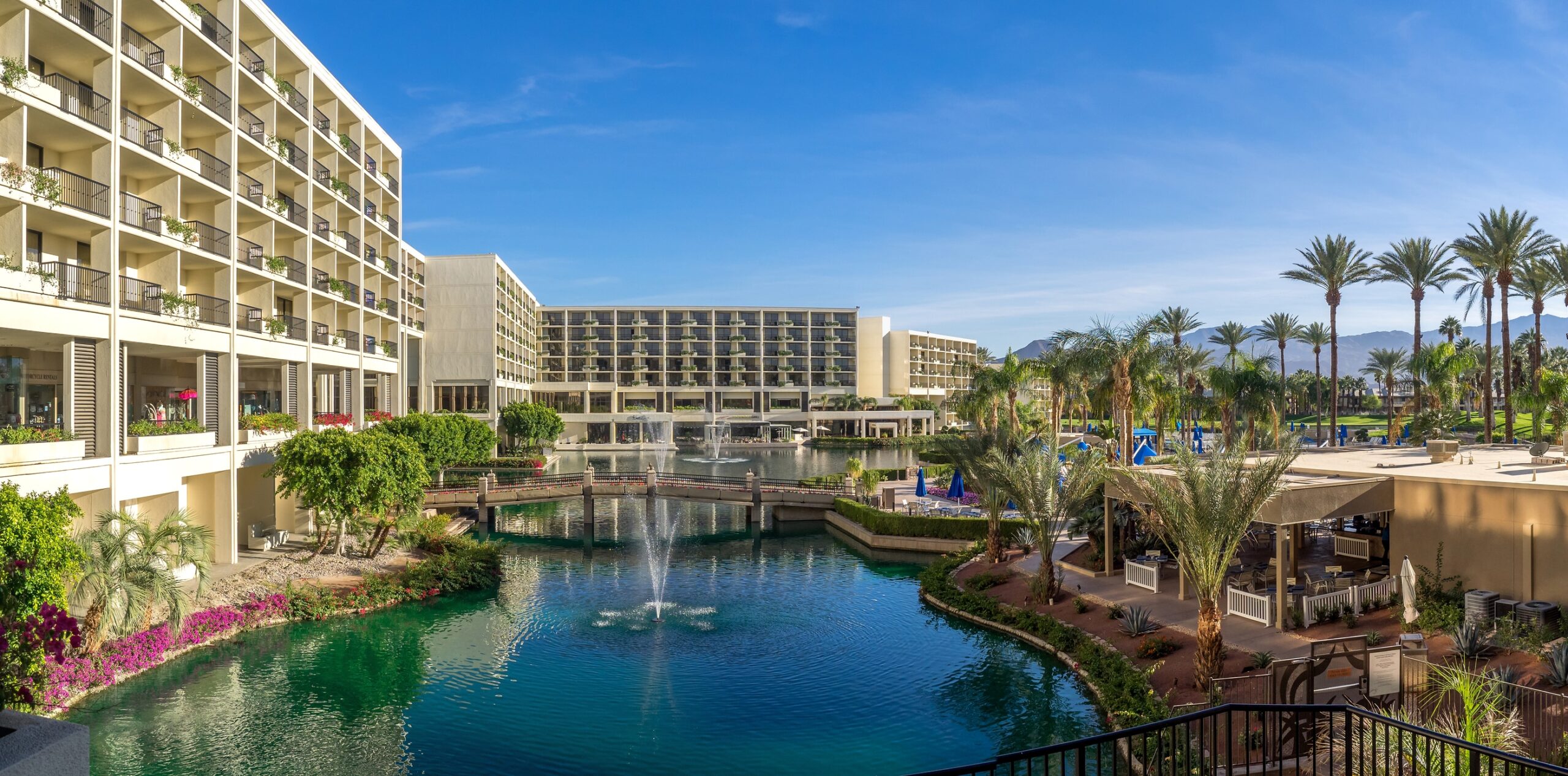[vc_row njt-role=”people-in-the-roles” njt-role-user-roles=”administrator,editor,author,armember”][vc_column][vc_column_text]
The hotel industry is doing well. Marriott International and Hyatt’s results bear witness to this. These two behemoths recently unveiled their second-quarter results, showing undeniable form thanks to winning development strategies.
During the second quarter, Marriott International, the world’s largest hotel group, demonstrated a strong performance. Headquartered in Bethesda, Maryland, the company saw its net profit increase by 7% to reach $726 million compared to the previous year. It also revised its full-year net profit projection upwards to at least $2.63 billion. Its revenue experienced an approximately 16% increase, reaching nearly $1.6 billion, once the collected and redistributed revenues to managed and franchised properties were deducted. The company showcased operational strength across its portfolio.
Marriott’s Revenue per Available Room (RevPAR) – a key performance indicator in the industry – rose by 13.5% compared to the previous year. Furthermore, the company increased the average room rate worldwide by 6% compared to the previous year.
“Continued global travel demand has led to another quarter of outstanding results,” emphasized Anthony Capuano, the President and CEO of the group. “In the U.S. and Canada, leisure sector revenues grew by 1% compared to the impressive second quarter of the previous year.”
Kathleen Oberg, the Chief Financial Officer, also expressed confidence: “Looking ahead to the third quarter, consumers are generally in good shape, and our future bookings remain strong.”
At the end of the quarter, Marriott’s total debt amounted to $11.3 billion. Cash and cash equivalents totaled $0.6 billion, compared to a debt of $10.1 billion. Additionally, cash equivalents of $0.5 billion were present at the end of 2022. From the beginning of the fiscal year until July 28th, the company repurchased 13.6 million shares for $2.3 billion.
Rising Interest in Mid-Range Category
Marriott is increasingly focusing on mid-range hotels. Despite having a portfolio of 30 brands that largely cater to the upper-tier segment – from Courtyard to The Ritz-Carlton – the company has committed this year to introduce more affordable hotels, one or two tiers below. This movement, called the “mid-range” category, aims to offer more upscale establishments than economy hotels while remaining “affordable” in price.
In May, the company officially acquired City Express, a hotel brand falling precisely into this category. In June, Marriott unveiled the expansion of a new extended-stay brand in the “affordable mid-range” category in North America. In July, the company announced a licensing agreement with MGM Resorts, enabling room reservations in 17 MGM properties through its website and app by the end of the year.
Many of these properties offer mid-range options. On Tuesday, Marriott hinted at a potential expansion into the mid-range category in Europe as well. The Marriott brand portfolio already includes Fairfield Inn in this category, with over 1,000 properties. However, Fairfield is positioned in the upper range of this category. Analysts at Melius Research noted that “Marriott is clearly sending a message that it wants to play a more significant role in the mid-range market, indicating an evolution in its brand strategy.”
Several reasons explain Marriott’s interest in mid-range properties. The profits from new hotels surpass costs, piquing investor interest. While short-term growth is strong, competition with Hilton, Accor, IHG, and Hyatt for upscale properties is fierce. Growth becomes more intricate over time, prompting a move towards the mid-range category to sustain growth. Due to their profitability for developers and lower management costs, mid-range hotels attract investors and owners. Marriott’s stock has recently risen by 18.6%, compared to the S&P 500’s 10% increase.
Development Pipeline
Marriott added 254 properties (33,097 rooms) to its global accommodation portfolio during the second quarter of 2023, including 17,300 rooms from the City Express transaction and approximately 11,200 additional rooms in international markets. The company also added over 2,800 converted rooms. Seventeen properties (1,995 rooms) left the system during the quarter. By the end of the quarter, Marriott’s global accommodation system encompassed nearly 8,600 properties, totaling more than 1,565,000 rooms.
At the end of the quarter, the company’s global development pipeline included 3,149 properties with nearly 547,000 rooms, of which 199 properties with about 31,500 rooms were approved for development but not yet under signed contracts. The pipeline includes 1,066 properties with over 240,000 rooms under construction, accounting for 44%, including around 37,000 rooms from the agreement with MGM Resorts.
Hyatt’s Growing Presence
Hyatt’s transformative growth plan is gaining traction in the Middle East and Africa, with four agreements signed in Saudi Arabia in the first half of 2023, an imminent brand expansion in Egypt, two brand launches planned in Qatar, and three brand launches expected in Kenya next year. Hyatt reported a global net profit of $58 million in the first quarter of 2023, compared to a net loss of $73 million in the first quarter of 2022.
Comparable system-wide RevPAR increased by 42.9% in the first quarter of 2023 compared to 2022. Adjusted EBITDA was $268 million in the first quarter of 2023, compared to $169 million in the first quarter of 2022. Hyatt plans to triple its portfolio in Saudi Arabia over the next five years. Hyatt is set to launch three brands in Kenya over the next twelve months, including the anticipated Hyatt Regency Nairobi, as well as the first dual-branded Hyatt property in Africa, the Hyatt House Nairobi, Westlands, and the Hyatt Place Nairobi, Westlands.
Middle Eastern Marques
Two of Hyatt’s lifestyle brands will debut in Qatar’s capital over the next twelve months, with the planned opening of Andaz Doha and the international launch of the Dream brand with Dream Doha, showcasing the group’s commitment to developing its lifestyle hotel portfolio in key destinations for customers, World of Hyatt members, and owners. Hyatt’s financial results for the first quarter of 2023 were recently announced in Dubai, reflecting the strength of the company’s global portfolio, particularly in Europe, the Middle East, and Africa (EMEA). Compared to the first quarter of 2022, Hyatt experienced a 256% revenue growth in managed and franchised hotels in EMEA, supported by strong performance in the Middle East and Western Europe, benefiting from robust international demand.
“For the fourth consecutive quarter, we have reported record results that have exceeded our expectations, demonstrating our unique positioning and differentiated model,” said Mark S. Hoplamazian, President and CEO of Hyatt. “We have raised our full-year RevPAR outlook while maintaining our pipeline at a record level and industry-leading net room growth. We continue to see favorable booking trends, and our outlook remains optimistic.”
In the Middle East, Hyatt’s presence continues to strengthen, with a tripling of its portfolio in the region over the past decade. Particularly in high-potential markets like Saudi Arabia, Hyatt plans to make a significant leap by tripling its number of hotels there over the next five years. This initiative is accompanied by the introduction of highly anticipated international brands, such as Miraval The Red Sea. Furthermore, Hyatt is preparing a major entry into Madinah, with three signature agreements totaling 1,729 keys this year. These agreements will lead to the launch of the Grand Hyatt Madinah, the Hyatt Regency Madinah, and the Hyatt Place Madinah in the city.
The Middle East region shows sustained demand for both business and leisure travel, providing positive prospects for the hotel industry. In another development focus, Hyatt plans to introduce two new lifestyle brands in Qatar over the next twelve months: Andaz Doha and Dream Doha. This will not only significantly expand the company’s portfolio in the Qatari capital but also offer World of Hyatt program members and travelers greater diversity in terms of lifestyle brands and unique experiences in this destination.
The upcoming months also hold particular significance for Hyatt’s growth projects in Africa. Three flagship brands are about to debut in Kenya: the highly anticipated Hyatt Regency Nairobi, as well as the first dual-branded Hyatt property in the region, the Hyatt Place Nairobi, Westlands, and the Hyatt House Nairobi, Westlands. Additionally, Hyatt recently announced the signing of an agreement to expand its presence in Egypt. In this regard, the lifestyle brand Hyatt Centric will make its appearance in the capital with the Hyatt Centric Cairo West, a project planned for the coming years.
Read also >Marriott and Hyatt raise their forecasts for the year
Featured photo : ©Press[/vc_column_text][/vc_column][/vc_row][vc_row njt-role=”not-logged-in”][vc_column][vc_column_text]
The hotel industry is doing well. Marriott International and Hyatt’s results bear witness to this. These two behemoths recently unveiled their second-quarter results, showing undeniable form thanks to winning development strategies.
During the second quarter, Marriott International, the world’s largest hotel group, demonstrated a strong performance. Headquartered in Bethesda, Maryland, the company saw its net profit increase by 7% to reach $726 million compared to the previous year. It also revised its full-year net profit projection upwards to at least $2.63 billion. Its revenue experienced an approximately 16% increase, reaching nearly $1.6 billion, once the collected and redistributed revenues to managed and franchised properties were deducted. The company showcased operational strength across its portfolio.
Marriott’s Revenue per Available Room (RevPAR) – a key performance indicator in the industry – rose by 13.5% compared to the previous year. Furthermore, the company increased the average room rate worldwide by 6% compared to the previous year.
“Continued global travel demand has led to another quarter of outstanding results,” emphasized Anthony Capuano, the President and CEO of the group. “In the U.S. and Canada, leisure sector revenues grew by 1% compared to the impressive second quarter of the previous year.”
Kathleen Oberg, the Chief Financial Officer, also expressed confidence: “Looking ahead to the third quarter, consumers are generally in good shape, and our future bookings remain strong.”
At the end of the quarter, Marriott’s total debt amounted to $11.3 billion. Cash and cash equivalents totaled $0.6 billion, compared to a debt of $10.1 billion. Additionally, cash equivalents of $0.5 billion were present at the end of 2022. From the beginning of the fiscal year until July 28th, the company repurchased 13.6 million shares for $2.3 billion.
Rising Interest in Mid-Range Category
Marriott is increasingly focusing on mid-range hotels. Despite having a portfolio of 30 brands that largely cater to the upper-tier segment – from Courtyard to The Ritz-Carlton – the company has committed this year to introduce more affordable hotels, one or two tiers below. This movement, called the “mid-range” category, aims to offer more upscale establishments than economy hotels while remaining “affordable” in price.
In May, the company officially acquired City Express, a hotel brand falling precisely into this category. In June, Marriott unveiled the expansion of a new extended-stay brand in the “affordable mid-range” category in North America. In July, the company announced a licensing agreement with MGM Resorts, enabling room reservations in 17 MGM properties through its website and app by the end of the year.
Many of these properties offer mid-range options. On Tuesday, Marriott hinted at a potential expansion into the mid-range category in Europe as well. The Marriott brand portfolio already includes Fairfield Inn in this category, with over 1,000 properties. However, Fairfield is positioned in the upper range of this category. Analysts at Melius Research noted that “Marriott is clearly sending a message that it wants to play a more significant role in the mid-range market, indicating an evolution in its brand strategy.”
Several reasons explain Marriott’s interest in mid-range properties. The profits from new hotels surpass costs, piquing investor interest. While short-term growth is strong, competition with Hilton, Accor, IHG, and Hyatt for upscale properties is fierce. Growth becomes more intricate over time, prompting a move towards the mid-range category to sustain growth. Due to their profitability for developers and lower management costs, mid-range hotels attract investors and owners. Marriott’s stock has recently risen by 18.6%, compared to the S&P 500’s 10% increase.
Development Pipeline
Marriott added 254 properties (33,097 rooms) to its global accommodation portfolio during the second quarter of 2023, including 17,300 rooms from the City Express transaction and approximately 11,200 additional rooms in international markets. The company also added over 2,800 converted rooms. Seventeen properties (1,995 rooms) left the system during the quarter. By the end of the quarter, Marriott’s global accommodation system encompassed nearly 8,600 properties, totaling more than 1,565,000 rooms.
[…][/vc_column_text][vc_cta h2=”This article is reserved for subscribers.” h2_font_container=”tag:h2|font_size:16|text_align:left” h2_use_theme_fonts=”yes” h4=”Subscribe now !” h4_font_container=”tag:h2|font_size:32|text_align:left|line_height:bas” h4_use_theme_fonts=”yes” txt_align=”center” color=”black” add_button=”right” btn_title=”I SUBSCRIBE !” btn_color=”danger” btn_size=”lg” btn_align=”center” use_custom_fonts_h2=”true” use_custom_fonts_h4=”true” btn_button_block=”true” btn_custom_onclick=”true” btn_link=”url:https%3A%2F%2Fluxus-plus.com%2Fen%2Fsubscriptions-and-newsletter-special-offer-valid-until-september-30-2020-2-2%2F”]Get unlimited access to all articles and live a new reading experience, preview contents, exclusive newsletters…
Already have an account ? Please log in.
[/vc_cta][vc_column_text]Featured photo : © Press[/vc_column_text][/vc_column][/vc_row][vc_row njt-role=”people-in-the-roles” njt-role-user-roles=”subscriber,customer”][vc_column][vc_column_text]
The hotel industry is doing well. Marriott International and Hyatt’s results bear witness to this. These two behemoths recently unveiled their second-quarter results, showing undeniable form thanks to winning development strategies.
During the second quarter, Marriott International, the world’s largest hotel group, demonstrated a strong performance. Headquartered in Bethesda, Maryland, the company saw its net profit increase by 7% to reach $726 million compared to the previous year. It also revised its full-year net profit projection upwards to at least $2.63 billion. Its revenue experienced an approximately 16% increase, reaching nearly $1.6 billion, once the collected and redistributed revenues to managed and franchised properties were deducted. The company showcased operational strength across its portfolio.
Marriott’s Revenue per Available Room (RevPAR) – a key performance indicator in the industry – rose by 13.5% compared to the previous year. Furthermore, the company increased the average room rate worldwide by 6% compared to the previous year.
“Continued global travel demand has led to another quarter of outstanding results,” emphasized Anthony Capuano, the President and CEO of the group. “In the U.S. and Canada, leisure sector revenues grew by 1% compared to the impressive second quarter of the previous year.”
Kathleen Oberg, the Chief Financial Officer, also expressed confidence: “Looking ahead to the third quarter, consumers are generally in good shape, and our future bookings remain strong.”
At the end of the quarter, Marriott’s total debt amounted to $11.3 billion. Cash and cash equivalents totaled $0.6 billion, compared to a debt of $10.1 billion. Additionally, cash equivalents of $0.5 billion were present at the end of 2022. From the beginning of the fiscal year until July 28th, the company repurchased 13.6 million shares for $2.3 billion.
Rising Interest in Mid-Range Category
Marriott is increasingly focusing on mid-range hotels. Despite having a portfolio of 30 brands that largely cater to the upper-tier segment – from Courtyard to The Ritz-Carlton – the company has committed this year to introduce more affordable hotels, one or two tiers below. This movement, called the “mid-range” category, aims to offer more upscale establishments than economy hotels while remaining “affordable” in price.
In May, the company officially acquired City Express, a hotel brand falling precisely into this category. In June, Marriott unveiled the expansion of a new extended-stay brand in the “affordable mid-range” category in North America. In July, the company announced a licensing agreement with MGM Resorts, enabling room reservations in 17 MGM properties through its website and app by the end of the year.
Many of these properties offer mid-range options. On Tuesday, Marriott hinted at a potential expansion into the mid-range category in Europe as well. The Marriott brand portfolio already includes Fairfield Inn in this category, with over 1,000 properties. However, Fairfield is positioned in the upper range of this category. Analysts at Melius Research noted that “Marriott is clearly sending a message that it wants to play a more significant role in the mid-range market, indicating an evolution in its brand strategy.”
Several reasons explain Marriott’s interest in mid-range properties. The profits from new hotels surpass costs, piquing investor interest. While short-term growth is strong, competition with Hilton, Accor, IHG, and Hyatt for upscale properties is fierce. Growth becomes more intricate over time, prompting a move towards the mid-range category to sustain growth. Due to their profitability for developers and lower management costs, mid-range hotels attract investors and owners. Marriott’s stock has recently risen by 18.6%, compared to the S&P 500’s 10% increase.
Development Pipeline
Marriott added 254 properties (33,097 rooms) to its global accommodation portfolio during the second quarter of 2023, including 17,300 rooms from the City Express transaction and approximately 11,200 additional rooms in international markets. The company also added over 2,800 converted rooms. Seventeen properties (1,995 rooms) left the system during the quarter. By the end of the quarter, Marriott’s global accommodation system encompassed nearly 8,600 properties, totaling more than 1,565,000 rooms.
[…][/vc_column_text][vc_cta h2=”This article is reserved for subscribers.” h2_font_container=”tag:h2|font_size:16|text_align:left” h2_use_theme_fonts=”yes” h4=”Subscribe now !” h4_font_container=”tag:h2|font_size:32|text_align:left|line_height:bas” h4_use_theme_fonts=”yes” txt_align=”center” color=”black” add_button=”right” btn_title=”I SUBSCRIBE !” btn_color=”danger” btn_size=”lg” btn_align=”center” use_custom_fonts_h2=”true” use_custom_fonts_h4=”true” btn_button_block=”true” btn_custom_onclick=”true” btn_link=”url:https%3A%2F%2Fluxus-plus.com%2Fen%2Fsubscriptions-and-newsletter-special-offer-valid-until-september-30-2020-2-2%2F”]Get unlimited access to all articles and live a new reading experience, preview contents, exclusive newsletters…
Already have an account ? Please log in.
[/vc_cta][vc_column_text]Featured photo : © Press[/vc_column_text][/vc_column][/vc_row]











